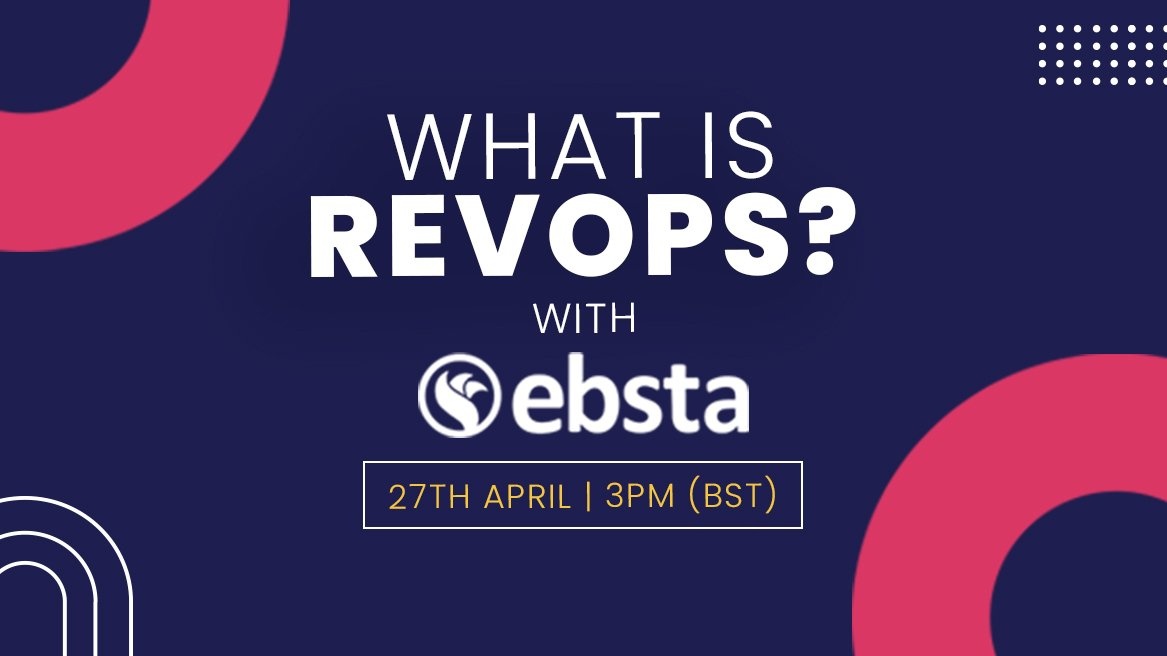






We've teamed up with HubSpot and Ebsta to bring you a four-part webinar series on what RevOps is, and how to find success by shifting your focus towards revenue growth and strategy. Keep reading to find out what you missed in the first part of this webinar series, featuring Guy Rubin, Founder & CEO of Ebsta.
What is RevOps?
Before we get into the webinar recap, let's take a step back and refresh ourselves on what RevOps actually is.
In practice, revenue operations (or RevOps) align marketing, sales, and customer success teams through the customer lifecycle in order to drive revenue growth.
Through better collaboration and visibility, RevOps provides focus on closing gaps in the customer lifecycle through improved operational efficiency. These gaps span across people, data, processes, technology, and team accountability.
Now, picture an orchestra. When you start to think about what makes a good RevOps function in a business, think of it like building an orchestra from scratch. The end goal is to get everyone to play their part of the same song, at the same time.
How RevOps has grown in businesses
Since 2019, there's been a 300% increase in RevOps-related roles on LinkedIn. In addition, we've seen a 57% increase in companies implementing RevOps strategies or building RevOps teas.
Here are some additional statistics that speak to its impact:
- 10-20% increase in sales productivity
- 15% increase in profitability
- 19% increase in speed of growth
- 71% improvement in stock performance
- 100-200% increase in digital marketing ROI
Once you get the synergy going between your go-to-market teams, the positive impact on your business will be substantial. There's no need to start from scratch, either. Feel free to use some of your current resources (like your tech stack) to start moving towards real revenue growth.
6 ways Software-as-a-Service (SaaS) has changed customer and business relationships
These are the 6 main ways SaaS has altered relationships between customers and the businesses they buy from:
- Most revenue is achieved after the point-of-sale.
- Traditional funnels are dead, and now customer journeys are non-linear.
- Customers have thousands of options at their fingertips.
- Customers are consistently demanding a more personal experience.
- There are typically more stakeholders involved in a purchase decision.
- The rate of change is ever increasing.
To provide this quality of customer experience, you'll have to spend some cash up front. But, the money you'll likely spend to secure a customer (or the cost of acquisition) is only a small fraction of what you can expect to earn from them over the course of their customer lifecycle. These earnings can come in the form of upsell or cross-sell business, as well as referrals.
Long story short: Look at the customer lifetime value over the value of the initial deal size.
How to break down silos for go-to-market teams
When it comes to the go-to-market model, marketing and sales departments often operate with their own data sets, knowledge, and processes. Once the customer is in the post-sales stage of the customer lifecycle journey, customer service builds up its own unique experience with that customer that is separate from the other two teams.
The three main components that should be aligned between these teams are data, technology, and processes. Once you're in pursuit of implementing a RevOps strategy in your business, having a consistent approach is the cornerstone you should focus on.

Ideally, the VP of RevOps (should you choose to hire one) will sit at the same table as all of your other go-to-market team leaders. Since they have the vision around the best RevOps strategy for your business, they shouldn't be viewed as a subordinate.
You hired them to bring in the best plan for achieving revenue growth, so let them and their team handle the strategy around objections, team enablement, gathering insight, and using tools.
The 5 main benefits of RevOps
|
From |
To |
|
Time wasted comparing info |
Data-driven decision-making and better collaboration |
|
Tension created in hand-offs with "it's not me, it's them" attitude |
Complete visibility and accountability across all teams |
|
Individual reports and processes |
Single source of truth shared by everyone |
|
Subjective forecasting and many "make or break" months |
More consistent and predictable pipeline and business growth |
|
Everyone working for themselves in isolation |
Better customer experience leading to higher win rates and faster sales cycles |
In a nutshell, think of these benefits as:
- Making better decisions faster
- Getting the right data in hand to make those decisions
- Building trust and predictable pipeline
Key performance indicators (KPIs) for RevOps
There are several key performance indicators (KPIs) to pay attention to when it comes to RevOps. When you're building out your RevOps function, the three main things to evaluate are:
- Customer churn
- Revenue per employee
- Account relationship score
Have an open and honest conversation about these KPIs in your go-to-market department. No one likes to talk about churn, but it's best to be honest about what this number looks like so that you can all band together to fix the hole in the proverbial bucket.
Revenue per employee is straightforward, and a number that every quota-carrier should be aware of and be ready to speak about.
Last but not least, relationship scoring involves getting a deep understanding of what customer relationships are strong and which could use more attention. At the end of the day, relationships drive revenue.
7 common RevOps challenges to avoid
As a newer concept in business, there are tons of things to consider when it comes to implementing RevOps. Whenever there's a huge change coming to a business, you'll see skeptics and naysayers all around. Try to focus on articulating the benefits of a RevOps model from a growth perspective. At the end of the day, all go-to-market teams should be focused on growth in the form of revenue anyways.
Although there are countless challenges to overcome, here are 7 common ones to watch out for:
- Lack of buy-in from business leaders
- Lack of alignment on customer journey
- Lack of internal expertise or ownership
- Lack of budget
- Too much technology
- Lack of feedback loops
- Temptation to "put a plaster over the wound"
Some highlights from the Q&A portion:
- What does a RevOps team look like and how does it scale with company size? What skills are needed? And how do you get started building a RevOps team?
A: Different teams are going to need different resources. Start with a leader; get someone in who has experience in this area. Be brave, as no one has all the answers as to what they're hoping to achieve with RevOps. RevOps is not an admin function, but strategic.
- Do you think that every scale-up needs to employ this discipline in the start and then avoid siloed conflict at a later stage?
A: The earlier you can justify, the quicker you can scale. Get the right people in to help you run faster.
- What skill set would a RevOps person [or leader] need?
A: Think about what they were doing before the term started to gain popularity. It would be people responsible for leading SDR teams, or responsible for GTM tech and getting the word out within an organisation. Maybe they haven't had the freedom or recognition to flourish. Look forward to a track record of success whilst fighting against a tide.










